It is no secret that, in order to win consistently at Blackjack, players need to follow a reliable strategy and stick to it throughout the game. Many of them choose to use basic strategy, as it is one of the most popular methods around the world. Moreover, all it takes to apply it during the game is to memorise its patterns and moves.
Another extremely popular approach is card counting, mainly because it has proven to be very effective throughout the years. Both strategies have their pros and cons, and it is entirely up to players’ preferences to decide which one suits them best.
However, it is worth mentioning that, in order to apply card counting successfully, players need to be familiar with the basic strategy principles, as this helps them to understand the patterns of the game, as well as the logic behind it.
What is Card Counting
Card counting is a strategy that allows players to predict, to some extent, whether the next card will be beneficial for them or not. As the name hints, its fundamental principle is based on following all of the cards on the table in order to determine the likelihood of receiving a particular one.
In general, card counting is considered a strategy for more advanced players, as it requires greater concentration and analytical skills. Its main objective is to enable them to alter the casino’s built-in advantage in their favour by keeping track of the cards.
In this way, players have the chance to reduce their monetary losses to a minimum by increasing their wagers only when the upcoming cards are likely to be favourable.
A deck is in the player’s favour when there are more power cards (A, K, Q, J, 10) than weak ones (2 through 6). The reason is that, if they know high-value cards predominate, they realise that whenever they hit, the likelihood of receiving such a card is higher.
Thus, they can make better decisions about their next move and adjust their bets and strategy plays accordingly. For instance, they might choose to hit even with hands that risk busting, provided the deck is richer in low-value cards, as this is less likely to cause them to go bust.
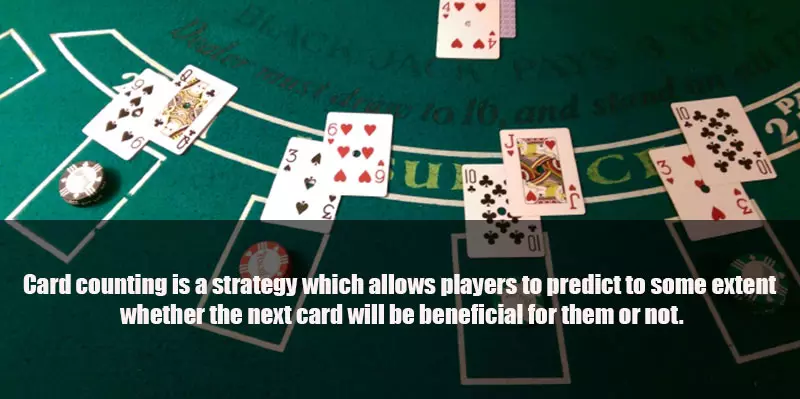
Cards Are Not Created Equal in Blackjack
No other casino game matches blackjack in terms of being exploitable. It all comes down to two mathematical concepts, those of dependent and independent events. Most casino games, including staples like roulette and craps, revolve around independent trials, i.e. the odds reset after each wheel spin or dice roll.
The likelihood of a given outcome occurring next is not influenced by what has happened in the past. The outcomes’ probabilities remain the same no matter how many times you have spun the wheel or rolled the dice. No helpful or accurate information can be gained from previous independent trials. Scouting for hot streaks in such games is pointless in the absence of predictability.
In the game of 21, however, consecutive hands are dependent trials, which is to say previous results can and do affect the probabilities of future outcomes. Once a given card is dealt on the felt, you cannot expect it to reappear before the dealer puts it back in the deck and reshuffles.
In a single-deck game, if a player is dealt two aces on the first round, immediately after the dealer has reshuffled, while two other players have received blackjacks, nobody will receive any naturals until the next shuffle, since there are no aces left in play. In this example, the house has a huge edge against the three patrons, who are at a correspondingly big disadvantage.
This is due to another peculiarity of blackjack, namely the fact that not all cards are created equal. In the game of 21, we can distinguish between player-favourable cards (A, K, Q, J, 10), house-favourable cards (2, 3, 4, 5, 6), and neutral cards (7, 8, 9). The odds fluctuate between the house and its patrons, depending on which cards are dealt and the composition of the undealt deck or shoe.
The removal of each card has a different effect on the expectation of the house and its players, as you can clearly see in the chart provided below (the estimates are taken from Peter Griffin’s great book The Theory of Blackjack: The Compleat Card Counter’s Guide to the Game of 21). This is a statistically sound fact, proven by countless computer simulations involving millions of played hands under specific rule sets as benchmarks.
| Card Removal Effect in Single-Deck Blackjack Games | |
|---|---|
| Denomination of Removed Card | Effect of Removal in % |
| 2 | 0.38% |
| 3 | 0.44% |
| 4 | 0.55% |
| 5 | 0.69% |
| 6 | 0.46% |
| 7 | 0.28% |
| 8 | 0.00% |
| 9 | -0.18% |
| K, Q, J, 10 | -0.51% |
| Ace | 0.61% |
Here is how the simulations work. They remove, for example, a 3 from the deck and calculate the expected value of the basic-strategy player when this particular denomination is missing. The computations are then repeated with another removed card, say an ace, and so on. The casino’s advantage is compared for each missing card to determine what effect its removal has on the players’ expected losses and profits.
If you pull out a deuce from a single deck, the absence of this card would boost the players’ expectation by 0.38%. Remove a Queen from a freshly reshuffled pack, and your expectation will drop by 0.51%. Provided that a deuce is dealt next to a ten-value card, the players’ negative expected value would be equal to (-0.51) + (+0.38) = -0.13%.
As is obvious from the chart above, high cards such as Q, J, K, A and 10 favour the players, boosting their expectation. Conversely, their removal causes the player’s advantage to drop. Low-value cards like the deuce work to the dealer’s advantage, so their removal increases your edge.
If you are tracking the ratio of low to high cards, you should press your bets when you have the edge and bet less, or sit out, when the advantage swings back in favour of the dealer. Many different card-counting systems effectively account for the strength of different card denominations.
Before we proceed any further, we would also like to specify that the cards’ removal effect decreases the more decks you add to the game. This is because the effect of dealing any given card becomes diluted; the absence of a single card has less impact on the players’ gains or losses.
Low Cards Help the Dealer, High Cards Help the Player but Why?
If you are serious about playing blackjack at an advantage, it is essential to understand why an excess of high cards harms the dealer and why prevalent low cards harm the player. Both answers relate to the basic rules of the game.
The dealer is bound by house rules to hit hard totals of 12 through 16 until they either bust or arrive at a standing total of 17 or above. The dealer is in trouble whenever there are more ten-value cards to come, because drawing one such card would cause them to break these hard hands. The opposite is true when low cards dominate the deck – the dealer is more likely to draw to a good total without the risk of breaking.
There are several reasons why the prevalence of high cards helps the player. First, the player stands better chances of receiving blackjacks with this deck composition. Of course, the same is true for the dealer. The difference is that, unlike the dealer, who collects even money for their blackjacks, the player receives a bonus payout of one-and-a-half times their winning bet (3 to 2) when they have a natural.
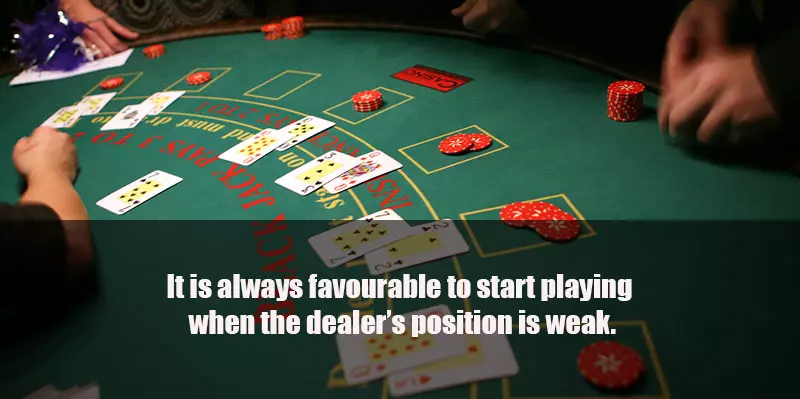
Then again, the player will see more successful double downs during ten-rich decks, since there are more high cards to give them solid hands with a single hit. Doubling normally occurs against weak low cards of the dealer, and the chances of the dealer busting when starting with a low card increase further whenever high cards outnumber low cards.
These tendencies are also observed with pair splitting. Splits of pairs such as 8-8, 9-9 or 7-7 become more profitable for the player whenever the deck is richer in high cards. Another benefit of card counting stems from the fact that insurance becomes a good bet when more tens and aces remain to be dealt.
The chances of the dealer flipping over a card to complete a blackjack rise as more high cards remain unplayed. By contrast, basic-strategy players never take the insurance bet because they have no knowledge of the deck’s current composition. Insurance carries a huge house edge with a neutral deck or shoe.
The Essentials of Card Counting
The premise of card counting is not difficult to understand. You track the cards as they are dealt to gain knowledge of the changing composition of the deck or shoe. Bets are increased only when there are more unplayed tens, as this is when the edge swings in favour of the player. Whenever more small cards remain, the house regains its advantage.
The player would either bet the table minimum or not bet at all, a technique known as “wonging out” after expert Stanford Wong, who coined it. So far, so good. The trouble is that mastering card counting requires a decent amount of time, patience and practice. Additionally, there are several other aspects you need to master to become a winning card counter.
Basic Strategy and Playing Deviations
You must commit perfect basic strategy to memory before you even begin to think about learning to count cards. This venture would be completely useless without basic strategy (BS). There are several reasons for this. To begin with, between 60% and 80% of counters’ advantage results from the use of basic strategy.
You can gain an edge simply by betting in correlation with your advantage and using BS. Furthermore, you need to use BS after the reshuffle until enough cards are dealt to change the deck or shoe composition significantly. The remaining 20% to 40% of a card counter’s advantage results from the use of playing deviations, also known as indices.
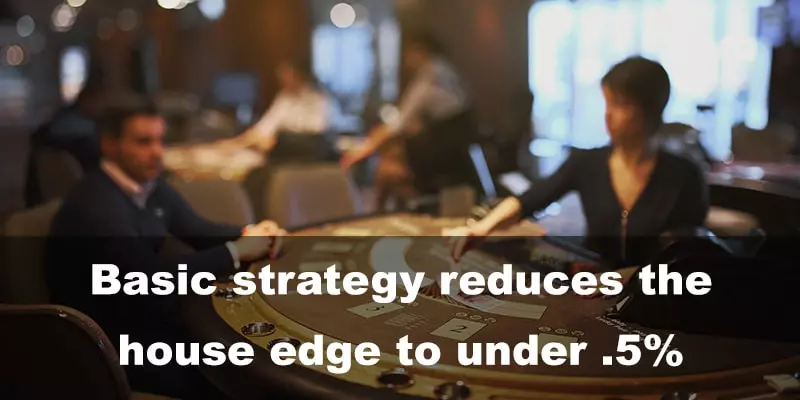
Indices denote the times when players must deviate from BS because the composition of the deck or shoe justifies it. One great example of a playing deviation is to take the insurance bet whenever the True Count rises to +3 or above.
Similarly, on neutral or positive counts, i.e. 0 or higher, a hard 16 versus a 10 is no longer a hit or a surrender; it becomes a stand for advantage players. There are many different indices, but novice card counters are generally advised to start with Donald Schlesinger’s Illustrious 18. This blackjack expert researched many playing deviations in the 1980s and established that these 18 indices offer the highest profitability.
Also important is to learn the Fabulous 4, which comprises four indices for the surrender play. One example is the hard 14 versus 10 index. As you will have learned from this guide, this hand is a hit versus a 10 with basic strategy in shoe-dealt blackjack. However, this hard total becomes a surrender against the 10 whenever the True Count rises to 3 or above.
If you are keen on maths and want a more profound understanding of blackjack advantage play, we recommend that you check out Mr. Schlesinger’s book Blackjack Attack: Playing the Pros’ Way. There, you will find all the Illustrious 18 and Fab 4 indices along with a wealth of information on team play, spreading your bets, camouflage play and analysis of players’ risk. A little more information on playing deviations is also available in our article here.
Choosing a System and Assigning Tags to Dealt Cards
Once you have learned perfect basic strategy, you need to pick the card counting system that best suits your style and goals. There are many different systems, each with varying levels of complexity and efficiency. The numerical tags assigned to high, low and neutral cards also differ across systems. The Speed Count and the Ace-Five Count are two of the easiest systems to learn and implement. They are recommended for novice counters.
Rookies should steer clear of highly complex systems like Wong Halves. Using them is likely to result in too many playing errors, which, in turn, leads to a drop in the system’s efficiency. Mistakes can completely cancel out the slightly higher edge that complex systems yield.
Most counters prefer to use the Hi-Lo system because of its relative simplicity and respectable level of efficiency. The system has been proven effective by many professional players and teams, including The Church Team (active 2005-2011) and the MIT Blackjack Team (1979-1993). These professionals extracted millions of dollars in gains from casinos’ coffers by using the Hi-Lo.
Players who utilise the Hi-Lo count assign the following numerical tags to the cards: 2 through 6 = +1, 7 through 9 = 0, and 10, K, Q, J and A = -1. Your goal is to add or subtract these values after every dealt card to keep what is known as the Running Count (RC).
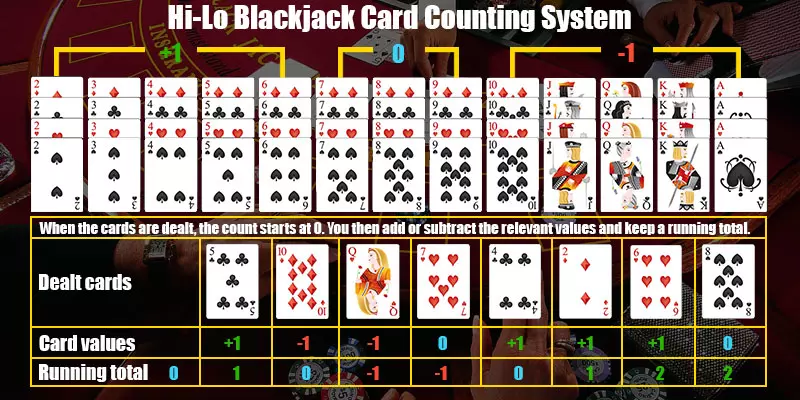
Here is an example of how the Hi-Lo works. Three players are sitting at a blackjack table. Player A is dealt 3-A, Player B receives Q-Q, and Player C gets 8-2. The dealer shows a 5. It follows that you have a Running Count of zero, since 3-A is 0, Q-Q is -2, 8-2 is +1 for -1, and the 5 is another +1 for 0. With Hi-Lo, the player begins to gain an advantage at a True Count (TC) of +1. The edge increases by half a per cent for every +1 added to the TC.
Running to True Count Conversion
Back in the 1960s and 1970s, keeping a Running Count like in the example above would have been sufficient to give you an edge, since all blackjack tables used single decks. The trouble was that casinos quickly wised up after Edward Thorp published his now-iconic book Beat the Dealer, in which he introduced the notion of card counting.
Casinos became worried (and for good reason) and decided to introduce multiple decks into play in the hope of hindering advantage players. The good news is that this did nothing to prevent skilled patrons from exploiting blackjack games.
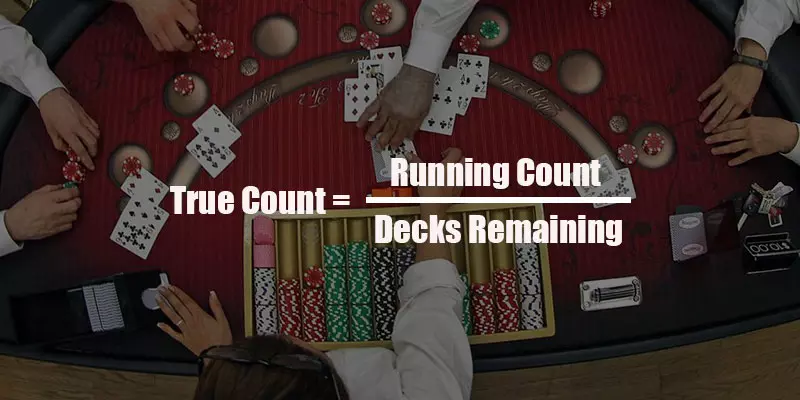
Players can still gain a decent edge in multiple-deck blackjack as long as they convert their Running Count (RC) into a True Count (TC). The True Count is the count per undealt deck. The conversion involves dividing your current Running Count by the number of decks still in play, i.e. TC = RC / RD, where RD stands for “remaining decks”.
One example of this is when you have an RC of +2 in a six-deck game and you see two decks in the discard tray and four decks in the shoe. Thus, you have a TC of 2 / 4 = 0.5, which is to say you are yet to overcome the house edge and press your bets.
Deck Estimation
To convert your Running Count into a True Count accurately, you need to learn deck estimation, i.e. determining correctly how many decks have been played and how many remain to be dealt. You will be surprised to find this is easier said than done, though. Nonetheless, you need accuracy in this respect to count cards successfully.
There are different approaches to learning deck estimation. Similarly to choosing a counting system, you should again opt for the approach that works best for you. Some novice counters prefer to divide by the nearest full pack to avoid complex calculations.
However, players looking for greater accuracy (which translates into greater advantage) can upgrade to dividing by the nearest half pack. This would add approximately 5% to your expected value compared with dividing by the nearest full pack.
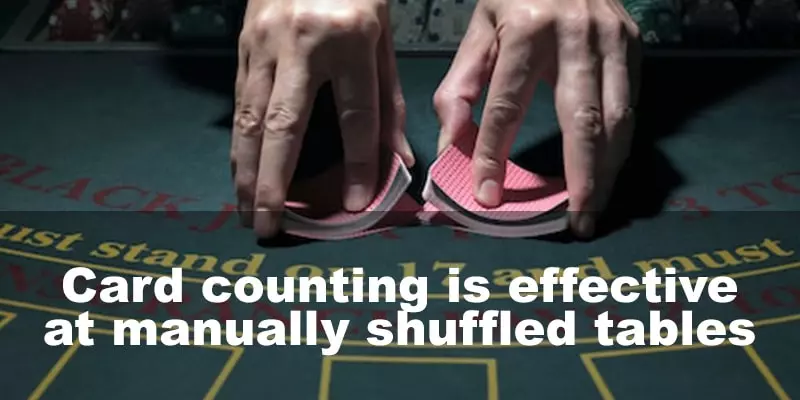
As for drills on deck estimation, all it takes is practice, although a sharp eye would also help. One commonly used approach is to buy many decks and divide them into stacks of 1, 1.5, 2, 2.5, 3 decks, etc. You can keep the cards in place by tying your stacks with rubber bands.
Contemplate the different stacks up close consistently until you can remember and visualise what each number of decks looks like. Indeed, you will have to work hard, as this is a cumbersome task that requires patience. Nonetheless, you cannot count cards in shoe-dealt blackjack without proper deck estimation and accurate RC-to-TC conversion.
Bet Spreads
Once you learn to count cards perfectly, you must pick a betting spread so you can size your wagers in proportion to your advantage. Counting cards is completely pointless if the player does not adjust their wagers in relation to the True Count. There is no uniform bet spread that suits all players. The choice of a betting ramp is based on many factors, including your personal level of comfort, your chosen casino’s tolerance, your bankroll and so on.
Table limits should also be taken into account. A player with lower risk tolerance might prefer to spread their wagers from £10 to £100, for example, whereas someone with a bigger bankroll and higher risk tolerance might be comfortable with a betting range from £10 to £200.

The bottom line is that you need to move your wagers with the increasing or decreasing TC. You also need to determine the highest ceiling for the True Count, i.e. how high you expect the TC to go during a given playing session. For instance, if you determine a TC of +10 for a spread of £10 to £100, you will have to bet in multiples of £10 and increase your wagers proportionately.
Here is an example: Negative or Neutral TC = £10, TC of +1 = £10, TC of +2 = £20, TC of +3 = £30, and so on until you reach a TC of +10 and press to the maximum of £100. Note that this is only a straightforward example for simplicity’s sake. Such high counts are a rare occurrence in multiple-deck games.
Advantages of Card Counting
One of the biggest advantages of card counting is that players can completely overturn the house edge and gain a long-term advantage. However, it should be noted that this can only be done if they are excellent card counters and have acquired the required concentration and discipline.
Players can also benefit greatly from it because it gives them the chance to turn a long-term profit, as they have the power to alter their bets in accordance with the remaining cards in the deck.
The idea that card counting can be learnt only by people with strong mathematical skills is wrong; it merely serves as an excuse for gamblers who are not willing to put enough effort and time into learning it.
What it really takes to master card counting is a lot of practice and dedication. In terms of the mathematics, it is worth mentioning that all calculations are very basic and should not pose an obstacle if you are comfortable with Year-4 maths.
Card Counting Systems
Hi-Lo System
Red Seven System
K-O System
KISS Systems
Disadvantages of Card Counting
One drawback of this strategy is that it requires a high level of concentration, and achieving this in a casino can be challenging. Players should be prepared to encounter many distractions around them and, therefore, must be disciplined enough to resist any temptations that might divert their attention.
Counting errors are costly, so the best course of action is to practise at home with distractions before you are casino-ready. Turn your TV volume up and ask some friends to join you in training to recreate the distracting atmosphere of the casino floor.
Card counting enables players to alter their decisions accordingly and take advantage of the information the cards provide. However, this can be a double-edged sword. Decisions made in the moment might be influenced by factors such as emotions or the surrounding environment. Thus, in such moments, discipline plays a crucial role and should never be underestimated.
Perhaps the biggest disadvantage of card counting is that many casinos are reluctant to accommodate players who practise it, as it gives them a huge advantage if applied correctly. For this reason, players should be cautious and try not to draw attention to their moves and bets. Many professional card counters avoid detection by using camouflage techniques to outwit the floor personnel.
Finally, there is the problem of finding playing conditions good enough to allow you to gain a sufficient edge. An increasing number of land-based casinos are beginning to offer poorer rules to thwart advantage players. They may impose unfavourable rule restrictions, use Continuous Shuffling Machines, or instruct their dealers to reshuffle at random and give players poor penetration.
Important Things to Consider Before Using Card Counting
Before using card counting, players should take several important factors into account. One of them is the number of decks involved in the game. This is essential, as the strategy’s main principle is based on the probability of which cards might appear next.
It is also worth mentioning that, even though players need to stay highly focused and follow every card, this does not mean they should remember every single one of them.
What they should really monitor is the ratio of strong to weak cards. This is a good indicator of whether they are likely to draw a high-value or a low-value card.
In most cases, if the shoe is rich in power cards, it works in favour of the players. Another very important point to consider is that, before they start practising card counting, it is recommended to master basic strategy first.
Card counting works best when combined with basic strategy because, even if players become perfect card counters, they will not achieve the desired results if they lack a fundamental knowledge of the game.
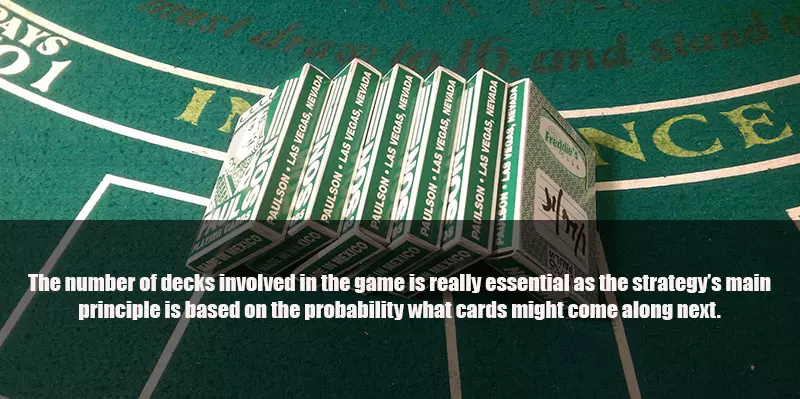
Conclusion
Card counting is a strategy that allows players to determine, based on the remaining cards in the shoe, whether or not they are in a favourable position. It is practised by many proficient players who know that it can give them a significant advantage over the casino.
To apply it correctly, it is best to be familiar with basic strategy and its patterns. The only way to achieve the desired result is to know the strategy inside out and use it throughout the game.
Combining both strategies gives players the valuable opportunity to win by using their skills and knowledge. This is why Blackjack is one of the most popular games in the world, played by millions of gamblers.



